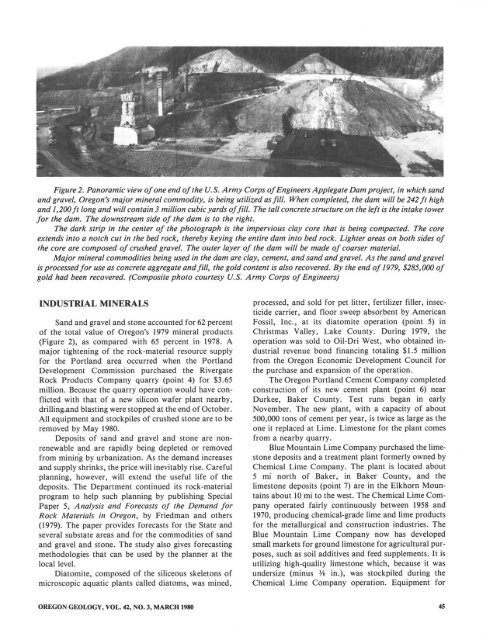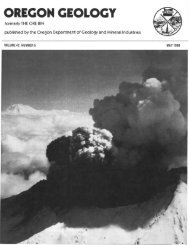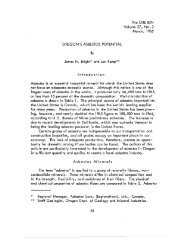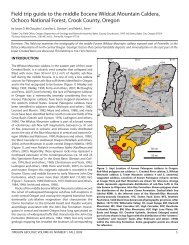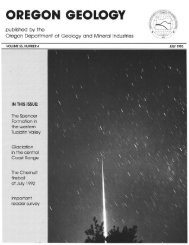Ore Bin / Oregon Geology magazine / journal - Oregon Department ...
Ore Bin / Oregon Geology magazine / journal - Oregon Department ...
Ore Bin / Oregon Geology magazine / journal - Oregon Department ...
Create successful ePaper yourself
Turn your PDF publications into a flip-book with our unique Google optimized e-Paper software.
Figure 2. Panoramic view of one end of the U. S. Army Corps of Engineers Applegate Dam project, in which sand<br />
and gravel, <strong>Ore</strong>gon's major mineral commodity, is being utilized as fill. When completed, the dam will be 242 ft high<br />
and 1,200ft long and will contain 3 million cubic yards of fill. The tall concrete structure on the left is the intake tower<br />
for the dam. The downstream side of the dam is to the right.<br />
The dark strip in the center of the photograph is the impervious clay core that is being compacted. The core<br />
extends into a notch cut in the bed rock, thereby keying the entire dam into bed rock. Lighter areas on both sides of<br />
'he core are composed of crushed gravel. The outer layer of the dam will be made of coarser material.<br />
Major mineral commodities being used in the dam are clay, cement, and sand and gravel. As (he sand and gravel<br />
is processed for use as concrete aggregate and fill, the gold content is also recovered. By the end of 1979, $285,000 of<br />
gold had been recovered. (Composite photo courtesy U.S. Army Corps of Engineers)<br />
INDUSTRIAL MINERALS<br />
Sand and gravel and stone accounted for 62 percent<br />
of the total value of <strong>Ore</strong>gon's 1979 mineral products<br />
(Figure 2), as compared with 65 percent in 1978. A<br />
major tightening of the rock-material resource supply<br />
for the Portland area occurred when the Portland<br />
Development Commission purchased the Rivergate<br />
Rock Products Company quarry (point 4) for $3.65<br />
million. Because the quarry operation would have conflicted<br />
with that of a new silicon wafer plant nearby,<br />
drilling.and blasting were stopped at the end of October.<br />
All equipment and stockpiles of crushed stone are to be<br />
removed by May 1980.<br />
Deposits of sand and gravel and stone are nonrenewable<br />
and are rapidly being depleted or removed<br />
from minin'g by urbanization. As the demand increases<br />
and su pply shrinks, the price will inevitably rise. Careful<br />
planning, however, will extend the useful life of the<br />
deposits. The <strong>Department</strong> continued its rock-material<br />
program to help such planning by publishing Special<br />
Paper 5, Analysis and Forecasts of the Demand for<br />
Rock Materials in <strong>Ore</strong>gon, by Friedman and others<br />
(1979). The paper provides forecasts for the State and<br />
several substate areas and for the commodities of sand<br />
and gravel and stone. The study also gives forecasting<br />
methodologies that can be used by the planner at the<br />
local level.<br />
Diatomite, composed of the siliceous skeletons of<br />
microscopic aquatic plants called diatoms, was mined,<br />
processed, and sold for pet litter, fertilizer filler, insecticide<br />
carrier, and floor sweep absorbent by American<br />
Fossil, Inc., at its diatomite operation (point 5) in<br />
Christmas Valley, Lake County. During 1979, the<br />
operation was sold to Oil-Dri West, who obtained industrial<br />
revenue bond financing totaling $1.5 million<br />
from the <strong>Ore</strong>gon Economic Development Council for<br />
the purchase and expansion of the operation.<br />
The <strong>Ore</strong>gon Portland Cement Company completed<br />
construction of its new cement plant (point 6) near<br />
Durkee, Baker County. Test runs began in early<br />
November. The new plant, with a capacity of about<br />
500,000 tons of cement per year, is twice as large as the<br />
one it replaced at Lime. Limestone for the plant comes<br />
from a nearby quarry.<br />
Blue Mountain Lime Company purchased the limestone<br />
deposits and a treatment plant formerly owned by<br />
Chemical Lime Company. The plant is located about<br />
5 mi north of Baker, in Baker County, and the<br />
limestone deposits (point 7) are in the Elkhorn Mountains<br />
about 10 mi to the west. The Chemical Lime Company<br />
operated fairly continuously between 1958 and<br />
1970, producing chemical-grade lime and lime products<br />
for the metallurgical and construction industries. The<br />
Blue Mountain Lime Company now has developed<br />
small markets for ground limestone for agricultural purposes,<br />
such as soil additives and feed supplements. It is<br />
utilizing high-quality limestone which, because it was<br />
undersize (minus ~ in.), was stockpiled during the<br />
Chemical Lime Company operation. Equipment for<br />
OREGON GEOLOGY, VOL. 42, NO.3, MARCH 1980<br />
45


